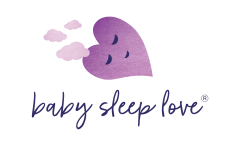
Baby Sleep Love
Certified Sleep Consultant

Swaddling: Benefits and Techniques
Swaddling is an age-old practice that has been used by parents around the world to help their babies sleep better. It involves wrapping a baby snugly in a blanket to provide a sense of security and warmth. Swaddling can be incredibly beneficial for newborns, but it’s important to do it correctly to ensure safety and effectiveness.
Benefits of Swaddling
Reduces Startle Reflex
Newborns have a natural startle reflex, which can cause them to wake up suddenly. Swaddling helps to suppress this reflex, allowing your baby to stay asleep longer and enjoy more restful sleep. On the flip side, there is some evidence that allowing a baby to sleep without a swaddle can help them work through this reflex earlier than if they had not been swaddled.
Provides a Sense of Security
The snugness of a swaddle mimics the feeling of being in the womb, providing comfort and security. This can help soothe a fussy baby and make it easier for them to fall asleep.
Prevents Scratching
Newborns often have little control over their arm movements and can accidentally scratch their face. Swaddling keeps their arms secure, preventing these accidental scratches.
Promotes Better Sleep
Swaddled babies tend to sleep more soundly and for longer stretches. This is beneficial not only for the baby but also for the parents, who can enjoy more uninterrupted sleep.
Techniques for Safe and Effective Swaddling
Choose the Right Blanket
Select a lightweight, breathable blanket to avoid overheating. Muslin and cotton are excellent choices because they are soft and allow for good air circulation.
Swaddle Securely but Not Too Tight
Wrap your baby snugly, but ensure there is enough room for their hips and legs to move. The swaddle should be tight enough to prevent the baby from breaking free but loose enough to avoid restricting movement and causing hip dysplasia.
Follow the ABCs of Safe Sleep
Always place your baby on their back to sleep, never on their stomach or side. Ensure the swaddle is secure and that there are no loose blankets or bedding in the crib. (A baby should never be swaddled while bedsharing).
Monitor for Signs of Overheating
Keep an eye on your baby’s temperature and adjust the swaddle or room temperature as needed. Signs of overheating include sweating, damp hair, flushed cheeks, and rapid breathing.
Transition Out of Swaddling
By about 8 weeks old, or when your baby shows signs of rolling over (whichever comes first), it’s time to transition out of swaddling. Your baby might do their first roll in their sleep, without any indication that they were going to do so. You don’t want them to get into a compromised breathing position that they can’t move themselves out of. You can transition gradually by leaving one arm out of the swaddle, then both, and eventually moving to a sleep sack. The swaddle transition can feel quite tough for some babies. Given this, some parents prefer not to swaddle at all right from the very beginning. That way, their babies learn the boundaries of their bodies as it relates to the boundaries of their sleep space early on.
Conclusion
Swaddling can be a powerful tool in your baby sleep routine, offering numerous benefits that contribute to better sleep for both your baby and you. By understanding the proper techniques and safety guidelines, you can ensure that your baby enjoys the soothing effects of swaddling while minimizing any risks. Remember, every baby is different, so it’s important to find what works best for your little one. Swaddling benefits Swaddling techniques Baby sleep solutions Newborn sleep tips Safe swaddling practices Preventing startle reflex Baby sleep aids Sleep training tips Baby sleep routines Swaddle transition Hip dysplasia prevention Best swaddle blankets Newborn sleep patterns Infant sleep habits Swaddle and SIDS Baby comfort techniques Muslin swaddle blankets Cotton swaddle blankets Swaddling safety tips Baby sleep consultant How to swaddle a baby Swaddling and overheating Transitioning out of swaddling Swaddle vs. sleep sack Baby bedtime routine
Have a baby around 4 months old that is suddenly not sleeping as well as they used to? It could be the 4-month sleep regression, which often hits parents hard.
Got a sleep situation that can’t be solved by the Baby Sleep Basics? Maybe it’s time to consider signing up for one of my Certified Sleep Consultant packages.
Follow Baby Sleep Love on Facebook and Instagram to get regular, free sleep advice.